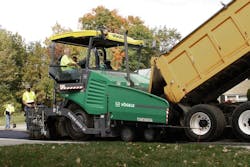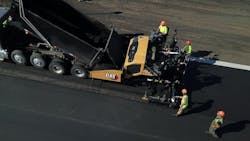How to Acquire Asphalt Pavers
Multiple screed choices give managers even more to consider when buying an asphalt paver, but the purchase decision still boils down to basics.
“First, consider where and how the paver will be used,” says Keith Hagy, product manager, Astec (parent of Roadtec). “This includes the application, size of job, environment, and the crew’s skill and preferences. You should also consider if you plan to use an MTV [material transfer vehicle]. Next, you’ll need to look at the specific features of the paver, such as flow gates, quick-change heads, and telematics.”
How to manage asphalt paver costs
To keep costs down, manufacturers stress maintenance, cleaning, and the use of telematics systems.
“Prevention is always better than repair,” Hagy says. “Take care of maintenance issues in advance. If you wait until something goes wrong, you’ve lost control of your schedule and are at the mercy of others to get back on track.
“One of the easiest things to do is keep the machines clean,” Hagy says. “A clean machine runs well, saving time and money. Cleaning extends the wear life, and when the machine is clean it’s easier to see potential issues.”
Hagy is also a proponent of using telematics to monitor systems. Astec/Roadtec’s system is called Guardian. “This data shows when maintenance is needed,” he says. “This information is valuable and allows you to schedule maintenance or repair to maximize time, money, and personnel. Also, before starting work, do a complete walk- around of the machine,” Hagy says. “Check all lights, fluid levels, and mechanical parts. At the end of the shift, wash down the machine. Approved solvent should be used to remove all material.”
Taking advantage of technology beyond telematics is also important when it comes to increasing productivity and efficiency.
“For example, Astec’s paver production reporting allows you to view the performance of your paver as it relates to real productivity,” Hagy says. “You can see tons per day, the day’s total paving distance, the live speed, and the total tons for the life of the machine.Using paver production reporting, the crew, and anyone with access to Guardian Telematics, can see real-time production from a paver to see how the day is going.”
What technology is on an asphalt paver?
Astec Roadtec RP Series highway class asphalt pavers have been updated with a new operator control system that incorporates intuitive touchscreen interfaces with improved functionality.
“We listened to our customers and worked hard to design new controls according to our customers’ needs,” Hagy says. “The operator panel showcases clear and easy-to-understand digital icons, allowing operators to more easily monitor the machine status. Additionally, the modern updates offer a more compact feel, with the control stations conveniently positioned within reach of the operators’ fingertips for an ergonomic experience.”
Caterpillar recently introduced four 8-foot paver models, including wheeled and tracked versions. A front-loading angle of 17 degrees and a high bumper clearance are designed to simplify loading without the use of additional blocking materials.
The pavers combine a low truck entry height with smaller, 14-inch diameter augers. Operators can control each material feed sensor when utilizing cut-off shoes or when paving at narrow widths; users can simply switch to manual and utilize the proportional control dial for the feed system.
Eco-mode combines with automatic speed control to reduce fuel consumption, according to the company, allowing the engine to operate at a lower rpm and still deliver the required power. If needed, the engine will automatically adjust to a higher engine speed if certain load conditions are met.
BOMAG’s latest pavers feature 7-inch multifunction color screen displays at each console that provide critical operating functions, gauges, parameters, and fault messages, the latter allowing troubleshooting at the job site to improve serviceability and paver uptime. Blade-type toggle switches, each controlling a single paver function, are designed to increase switch reliability and to provide fast, easy replacement anywhere, anytime, the company says.
A new sound-insulated composite engine hood is designed to reduce paver sound levels, and the hood’s sloped design provides a clear view into the hopper from the operator’s seat. Hopper wings are securely held in the up position with manual locks, meant to improve safety while servicing the machine.
The CR 820 Series incorporates three-point suspension “to float the paver over subbase irregularities and maintain preset screed slope and grade, delivering higher mat smoothness over commercial pavers with a fixed rear suspension,” says Chris Colwell, BOMAG’s VP of paving and milling.
The frame raise system allows raising and lowering the rear of the paver to adjust the head of material at the augers. A Smartrac feature automatically maintains proper track tension.
How to pick an asphalt screed
Managers have more screed choices than ever available to them. Here’s a sampling.
Caterpillar asphalt paver screeds pave from 8 feet to 15 feet 6 inches with a maximum width of 20 feet and 20 feet 6 inches, respectively. The screeds have paving depths up to 10 inches for aggregate paving applications.
The SE47 V screed utilizes extenders that are located behind the main screed, enabling material to flow out to the end-gates. The SE47 FM screed is equipped with extenders located in front of the main screed and offers a smaller footprint that reduces handwork at the start of the paving pass. The front-mounted extenders make it easy to quickly reduce paving widths when maneuvering around obstacles by drawing material back into the auger chamber.
The BOMAG Stretch 16 hydraulically extendible screed permits variable paving widths from 8 to 16 feet and a maximum paving depth of 12 inches. Quick-connecting extension kits can extend width to a maximum paving width of 20 feet. An automated screed lock keeps the screed securely in a raised position for transport, maintenance, and storage.
Blaw-Knox has four different screed options available for managers to choose from. Its Wedge-Lock screed series was the first introduced by the company, which is now owned by asphalt plant manufacturer Gencor. The Ultimat screed features front-mounted extensions that double screed width at the touch of a button. It is designed to do so without trapping asphalt and maintaining head-of-material control in the auger box.
The Omni 318 screed is a heavy-duty unit meant for wide-width high-volume paving projects. It has front-mounted hydraulic extensions, adjustable strike-off plates, and a paving width up to 26.5 feet. The Optimat 320-R screed is a rear-mount extension screed.
The Astec screed line includes the EVIV, which is front mount adjustable; EZ-R2, rear mount adjustable; and S Series, which is a rear mount fixed width unit. All screeds are available for 8-foot and 10-foot pavers.
The EZIV has a patented 2-percent tapered design that improves outboard flow of material whether the augers are running or not. This is made to keep material fluid and facilitate easier inboard/outboard extension movement. Utilizing a single slide extension support system, the EZIV reduces component replacement costs while achieving exceptional rigidity of its extensions, the company says. Competitive screeds utilize a two-stage slide track, Astec says, which is prone to more movement and has twice as many slide-track wear components.
EZR2 features an extension support system that eliminates flexing at wide widths; the EZR2 achieves paving up to 30 feet with the 10-foot platform.
The S-8 and S-10 Series screeds are fixed width, bolt-on extendable screeds. The bolt-on extensions are designed to go on easily and match the main screed plate. The S screeds reach 16 feet and 30 feet, respectively.


